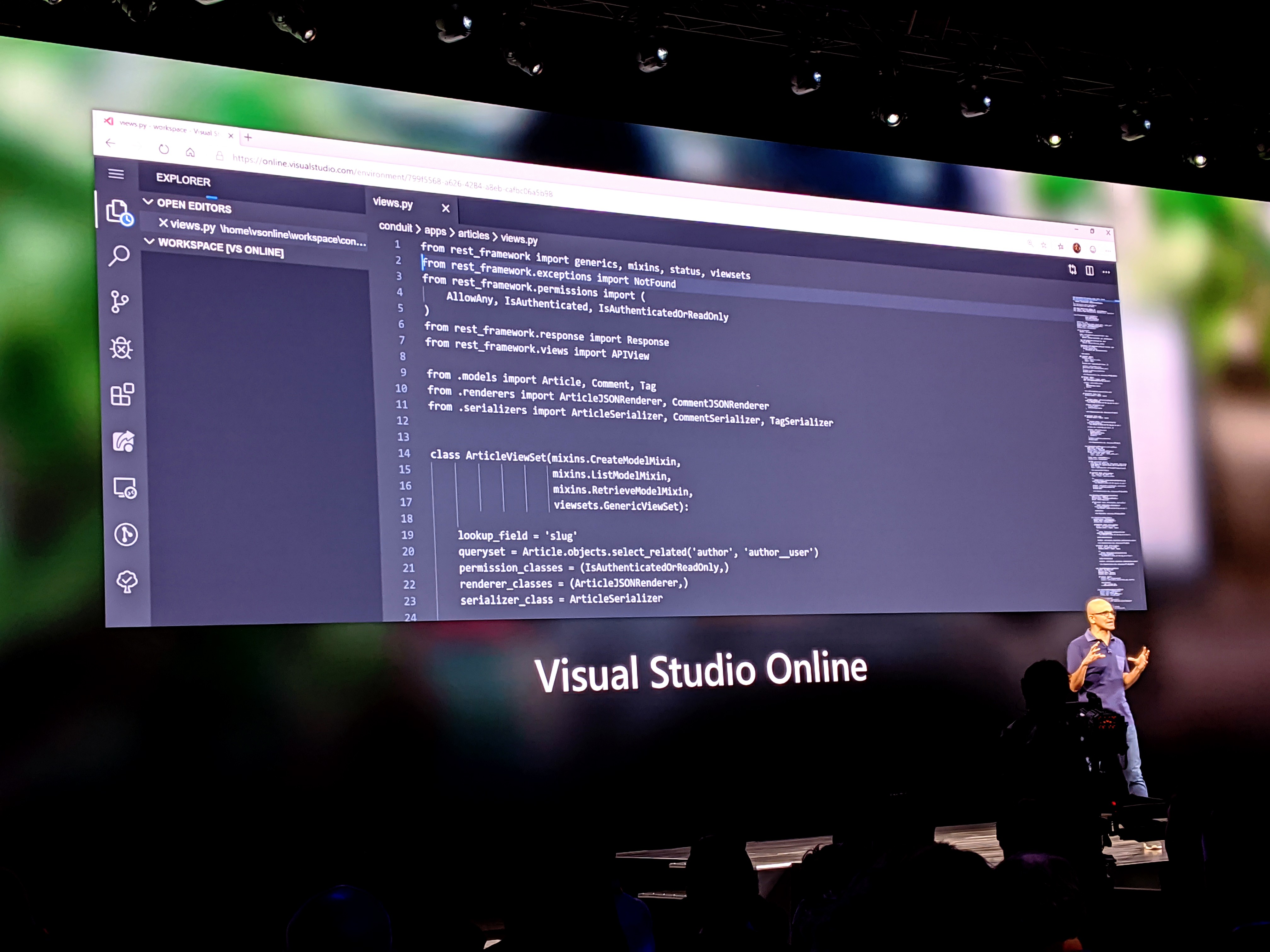Visual Studio is a versatile and powerful tool that plays a crucial role in the modern web development landscape. Here are key aspects of Visual Studio’s role in modern web development:

-
IDE for Web Development: Visual Studio stands out as a premier Integrated Development Environment (IDE) for web development, supporting various programming languages and web technologies. It offers intuitive coding editors, debugging tools, and intelligent code completion features that enhance developer productivity and accelerate the development cycle.

-
Comprehensive Language Support: Visual Studio supports a wide range of programming languages, enabling developers to work with multiple languages within a single IDE. It offers robust support for popular languages like C#, JavaScript, TypeScript, and Python, providing language-specific features, syntax highlighting, and error checking.

-
Web Project Templates and Scaffolding: Visual Studio streamlines web development by offering a multitude of pre-built project templates. These templates include common web application structures, enabling developers to quickly create new projects with pre-configured settings, dependencies, and files. Additionally, scaffolding allows for the automatic generation of code boilerplates, further simplifying the development process.
-
Integrated Debugging and Profiling: Visual Studio provides robust debugging capabilities that assist in identifying and resolving errors in web applications. Developers can utilize breakpoints, step-by-step code execution, and intelligent error messages to troubleshoot issues effectively. Furthermore, profiling tools within Visual Studio help analyze performance bottlenecks and optimize resource usage in web applications.
-
Cross-platform Development: With Visual Studio, developers can create web applications that run across different platforms and devices. It supports the development of websites, web services, ASP.NET Core applications, and mobile applications using various frameworks and technologies, enabling developers to target a broader audience and enhance accessibility.
-
Continuous Integration and DevOps Support: Visual Studio facilitates continuous integration and continuous delivery (CI/CD) practices, enabling automated builds, testing, and deployment of web applications. By integrating with tools like Azure DevOps, developers can implement automated pipelines, perform code reviews, and track the progress of their applications throughout the development lifecycle.
-
Collaboration and Team Development: Visual Studio promotes collaboration among developers by providing features such as version control integration with Git and other popular source control systems. It allows multiple developers to work on the same project efficiently, facilitating code sharing, conflict resolution, and merging of changes. Visual Studio also includes tools for real-time collaboration and code reviews, enhancing team productivity.
-
Rapid Prototyping and Code Refactoring: Visual Studio enables rapid prototyping by allowing developers to quickly create and experiment with different ideas. Its refactoring features assist in restructuring code, changing class hierarchies, and modifying function signatures while maintaining code integrity. These features accelerate the development process and help developers adapt to evolving requirements and improve code maintainability.
-
Extensibility and Customization: Visual Studio offers extensive extensibility options, allowing developers to enhance its core functionality with plugins, extensions, and add-ins. Numerous third-party extensions are available, catering to specific technologies, frameworks, and development methodologies, enabling developers to tailor the IDE to their unique needs and preferences.
-
Community and Support: Visual Studio is supported by a large and active community of developers and contributors who provide assistance, resources, and tutorials. Microsoft also offers comprehensive documentation, online forums, and dedicated developer support channels, ensuring that developers have access to up-to-date information and guidance.
In conclusion, Visual Studio plays a crucial role in modern web development by providing a comprehensive set of tools, features, and extensions that cater to the diverse needs of web developers. Its support for various programming languages, advanced debugging capabilities, cross-platform development options, and seamless integration with CI/CD and DevOps practices make it a powerful tool that increases developer productivity, streamlines the development process, and enhances the overall quality of web applications.## Visual Studio’s Role in Modern Web Development
Executive Summary:
This comprehensive article provides an in-depth analysis of Visual Studio’s role in shaping modern web development practices. By highlighting key subtopics such as cross-platform compatibility, project and code management, debugging tools, code refactoring, and the integration of extensions and plugins, we delve into the intricate capabilities of Visual Studio and its immense impact on streamlining and enhancing the workflow of web developers.
Introduction:
In the ever-evolving realm of web development, the selection of appropriate tools and technologies plays a crucial role in optimizing workflow, ensuring project success, and delivering high-quality applications. Among the plethora of available options, Visual Studio emerges as a prominent integrated development environment (IDE) that caters to the diverse needs of web developers. This article aims to shed light on the pivotal role of Visual Studio in modern web development, exploring its key features, functionality, and benefits.
Cross-Platform Compatibility:
Visual Studio’s cross-platform compatibility stands as a significant advantage, allowing developers to seamlessly work across various platforms and operating systems. This versatility empowers them to develop applications that can be deployed on multiple platforms, catering to a broader user base and expanding market reach.
-
Supports multiple programming languages and frameworks: Visual Studio supports a wide range of programming languages, including C#, Visual Basic, JavaScript, and Python, enabling developers to work with their preferred languages and frameworks.
-
Facilitates code sharing across platforms: Visual Studio facilitates code sharing across different platforms, allowing developers to reuse code and expedite the development process.
-
Promotes collaborative development: Visual Studio supports collaborative development through features like real-time code editing, version control integration, and seamless merging of code changes.
Project and Code Management:
Visual Studio offers robust project and code management capabilities, providing developers with the necessary tools and features to organize, navigate, and maintain complex web development projects effectively.
-
Solution Explorer: The Solution Explorer in Visual Studio enables developers to effortlessly organize and manage project files, references, and dependencies, facilitating quick navigation and easy project maintenance.
-
Project Templates: Visual Studio provides an array of project templates, offering predefined structures and configurations for various types of web applications, streamlining project setup and reducing development time.
-
Code Editing and Refactoring: Visual Studio’s powerful code editing and refactoring features empower developers to write clean, maintainable, and efficient code. Its intelligent editor provides auto-completion, error checking, and code formatting to enhance code quality and readability.
-
Debugging and Diagnostics: Visual Studio’s comprehensive debugging and diagnostics tools assist developers in identifying and resolving errors and performance issues. Features like breakpoints, watches, and debugging windows facilitate the efficient identification and correction of defects, reducing development time and ensuring application stability.
-
Integration of Extensions and Plugins: Visual Studio supports the integration of extensions and plugins, enabling developers to customize the IDE to suit their specific needs and preferences. This extensibility allows developers to enhance Visual Studio’s functionality and integrate additional tools and features to streamline their workflow and improve productivity.
Conclusion
Visual Studio’s profound impact on modern web development cannot be overstated. Its comprehensive suite of features, including cross-platform compatibility, advanced project and code management, sophisticated debugging tools, code refactoring capabilities, and seamless integration of extensions and plugins, empowers developers to create high-quality web applications efficiently and effectively. By leveraging the capabilities of Visual Studio, web developers can optimize their workflow, streamline development processes, and deliver exceptional user experiences.
Keyword Phrase Tags
- Visual Studio
- Web Development
- Cross-platform Compatibility
- Code Management
- Debugging Tools

Visual stabdio is a powerful tool for blobwre devellopment.
Y cant yu beleve
It’s a popular tool for building web applications because it offers a wide range of features and capabilities.
I’ve used Visual Studio for several years and I’ve found it to be a valuable tool for my web development work.
I really enjoy using Visual Studio for my web development projects.
It’s a great tool for both beginners and experienced developers.
It’s a powerful tool but it can be complex and difficult to learn.
What is a good tool for me
Is there any tool more powerful than this
Install the extension and enjoy your web development journey
Many developers find it to be a valuable tool for their web development work.
Has anyone used this